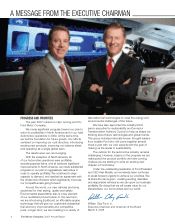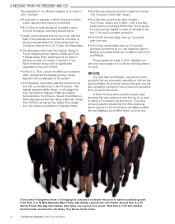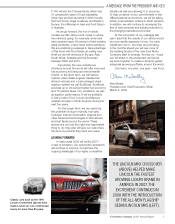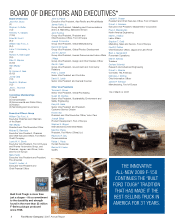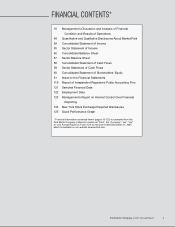Ford 2007 Annual Report Download - page 15
Download and view the complete annual report
Please find page 15 of the 2007 Ford annual report below. You can navigate through the pages in the report by either clicking on the pages listed below, or by using the keyword search tool below to find specific information within the annual report.
Management’s Discussion and Analysis of Financial Condition and Results of Operations
Ford Motor Company | 2007 Annual Report 13
Capacity alignment
We also have reduced and realigned our vehicle assembly capacity to bring it more in line with demand and shifting
customer preferences. There are several ways to measure our vehicle assembly capacity, two of which are installed
capacity and manned capacity. Installed capacity refers to the physical capability of the plant and equipment to assemble
vehicles if fully manned. Manned capacity refers to the degree to which the installed capacity has been staffed. In
addition, in North America there generally exists the capability to work overtime or schedule downtime to adjust the
manned capacity in the short term to match sales.
Since year-end 2005, we have reduced our North American manned capacity from 3.6 million units to 2.9 million units.
Reducing our manned capacity in this manner allows us to achieve major cost savings and coordinates plant closures
with planned product changes, which we believe is the best economic approach. We plan to reduce our manned capacity
in North America by the end of the decade so that it closely matches projected sales of Ford, Lincoln and Mercury units.
As part of this reduction, we have closed or announced plans to close the following North American manufacturing
facilities:
CLOSED:
•
Atlanta Assembly Plant (closed in 2006);
•
Essex Engine Plant (closed in 2007);
•
Maumee Stamping Plant (closed in 2007);
•
Norfolk Assembly Plant (closed in 2007);
•
St. Louis Assembly Plant (closed in 2006);
•
Windsor Casting Plant (idled in 2007); and
•
Wixom Assembly Plant (closed in 2007).
TO BE CLOSED:
•
Batavia Transmission Plant (to be closed in 2008);
•
Twin Cities Assembly Plant (to be closed in 2009); and
•
Cleveland Casting Plant (to be closed in 2010).
Additionally, we have sold or closed the ACH plants listed below, and plan to sell or close essentially all of the 11
remaining ACH plants by the end of 2008:
•
Chesterfield (Michigan) Trim Plant, which produced seat foam, closed in 2006;
•
Kansas City Regional Assembly, which performed final assembly of instrument panels, closed in 2006;
•
El Jarudo (Mexico), which produced automotive fuel rails, was sold in 2007; and
•
Converca (Mexico), which produced power transfer units, was sold in 2007.
New UAW Collective Bargaining Agreement
On November 3, 2007, we agreed in principle with the UAW on a new, four-year collective bargaining agreement
("CBA") and a separate memorandum of understanding relating to retiree health care benefits ("MOU", and together with
the CBA, "Agreements"). The Agreements were ratified by our UAW-represented employees on November 14, 2007.
The MOU is subject to several additional conditions, including court approval of a final settlement agreement and
satisfactory accounting treatment of the retiree health care benefits obligation.
The Agreements will enable us to increase our competitiveness in the United States through reduced retiree health
care costs, more competitive wages and benefits, and improved operational flexibility. Following are some of the
significant terms of the Agreements.



